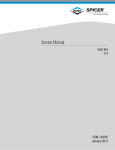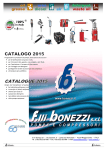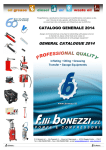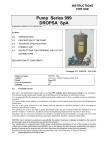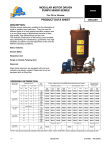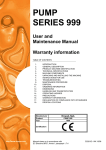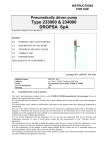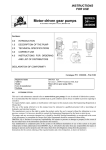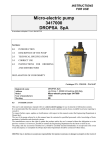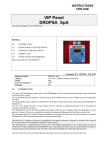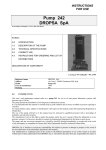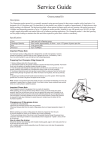Download Manual
Transcript
INSTRUCTIONS FOR USE Pneumatically driven pump Type 3413… Type 31040.. DROPSA SpA In accordance with point 1.7.4, to I, Dir. CEE 89/392 0.0 INTRODUCTION AND WARNING 1.0 DESCRIPTION OF THE PUMP 2.0 TECHNICAL SPECIFICATIONS 3.0 CORRECT USE 4.0 INSTRUCTIONS FOR ORDERING AND DISTRIBUTORS DECLARATION OF CONFORMITY Catalogue P/N C2008IE - Wk 05/99 Registered name Address Model Year of manufacture Marking DROPSA SpA via Croce 1, 20090 Vimodrone (MI), Italy Pneumatically/hydraulically driven pump 3413--- & 31040 1990 CE 0.0 INTRODUCTION AND WARNING This user’s and maintenance manual refers to series 3413--- and 31040 pneumatically driven pumps, for use in mineral oil or grease lubrication systems. It is recommended that this manual is carefully kept in good condition and is always available to persons requiring to consult it. To request further copies, updates or clarifications with respect to this manual contact the Engineering Department at Dropsa SpA. The use of the pump referred to in this manual must be entrusted to qualified personnel with a knowledge of hydraulics, mechanical and electrical systems; the non-observance of the information given in this manual or the improper use of the equipment by non-qualified or non-authorised personnel can put persons or the environment at risk due to the escape of fluids under pressure. It is of extreme importance that the instructions for use are read and understood both by the operators and maintenance personnel, in cases of doubt please contact the area representative or our “Customer Service” department. The manufacturer reserves the right to update the product and/or the user’s manual without the obligation to revise previous versions. It is however, possible to contact the Engineering Department for the latest revision in use. It is the responsibility of the installer to utilise tubing suitable for the system; the use of unsuitable tubing can generate problems with the pump, risks to persons and cause pollution. The loosening of connections can cause serious safety problems and all such connections should be checked before and after installation and tightened if necessary. Never exceed the maximum operating pressure values allowed for the pump and the components to which it is connected. Before any maintenance or cleaning operations, close off the air supply and release the pressure from the pump and the tubing to which it is connected. Do not subject the pump, the tubing or other parts under pressure to violent impacts; damaged tubing or connections are dangerous and should be replaced. After prolonged periods of inactivity, ensure the tightness of all connections subjected to pressure. It is required that personnel make use of protection devices, clothing and necessary tools, suitable to the place and employment of the pump both while in operation and during the undertaking of maintenance tasks. The pump, and any accessories mounted on it, should be carefully checked immediately on receipt and in the event of any discrepancy or complaint the Dropsa SpA Sales Department should be contacted without delay. DROPSA S.p.A. declines to accept any responsibility for injuries to persons or damage to property in the event of the non-observance of the information presented in this manual. Any modification to component parts of the system or the different destination of use of this system or its parts without prior written authorisation from DROPSA S.p.A. will absolve the latter from any responsibility for injury or damage to persons and/or property and will release them from all obligations arising from the guarantee. The list of importers and instructions for ordering the required model are shown in Section 4. 1.0 DESCRIPTION OF THE PUMP These pumps utilise compressed air to control the delivery of the lubricant and are ideal for lubrication systems installed on machines already supplied with compressed air. The solenoid control valve must be: 3 way (line-cylinder-discharge) for single action pumps 4 way (line-cylinder-discharges) for double action pumps Deliverable lubricant: mineral, not containing abrasive substances. Compressed air supply pressure: min. 4 bar (0.4 MPa) – max 8 bar (0.8 MPa) Tank filling valve: G 1/2 UNI-ISO 228/1 – only for pump 3413026 hydraulic connection Lubricant outlet: Rp 1/4 UNI-ISO 7/1 Compressed air inlet: for pump type 3413… G 1/8 UNI-ISO 228/1 fitting for 6 mm tube for pump type 31040.. G 1/4 UNI-ISO 228/1 fitting for 8 mm tube Filter for oil recovery (where fitted) in metal and/or paper. Magnet type electrical minimum oil level indicator. Maximum operating temperature: +80 °C C20008IE – Pneumatically driven pump - Rev. 0 February 99 Page 2 of 9 1.1 2.0 Accessories As per specific request. TECHNICAL SPECIFICATIONS 2.1 Methods of commanding the pump Manual push-button control Supply Discharge 3-way solenoid valve control Supply Discharge Mechanical roller or cam bar control Supply Discharge C20008IE – Pneumatically driven pump - Rev. 0 February 99 Page 3 of 9 2.2 Fixing dimensions 2.3 Other data NLGI grease rating at working temperature Viscosity of the lubricant at working temperature Working temperature Working humidity Preservation temperature Sound pressure level 3.0 CORRECT USE 3.1 Putting into service see table at sub-section 4.0 Between 15 - 2000 cSt + 5 - + 80 °C 90 % relative humidity. - 20 - + 50 °C < 70 dB(A) ♦ The unit may be used, opened and repaired only by specialised personnel. ♦ The pump MUST NOT be submersed in fluids or utilised in environments which are particularly aggressive or explosive/inflammable if not prepared for this purpose beforehand by the supplier. ♦ For correct fixing verify the distance between centres shown in the diagram in Section 2.2. ♦ Use gloves and safety glasses as required in the lubrication oil safety chart. ♦ DO NOT use aggressive lubricants with NBR gaskets and seals; if in doubt consult the Engineering Department of Dropsa SpA, who will provide a chart with the details of recommended oils. ♦ DO NOT ignore dangers to health and observe all hygiene standards. ♦ WARNING! All electrical components must be grounded. This refers to both electrical components and control devices. In this regard ensure that the ground cable is correctly connected. For reasons of safety the ground cable must be approx. 100 mm longer than the phase cables. In the event of accidental detachment of the cable, the ground terminal must be the last to be removed. C20008IE – Pneumatically driven pump - Rev. 0 February 99 Page 4 of 9 + action to be taken prior to start up Verify the integrity of the pump; Fill the tank with suitable lubricant (min/max indication on the tank); Verify that the pump is at operating temperature and the tubing free from air bubbles; Check that the electrical connections have been effected correctly (CEI 64/8, IEC 364); Verify the correct connections of any level and pressure switches to the control panel 3.2 Use 1. 2. 3. 4. 3.3 verify the settings on the control panel, where fitted; press the start button of the machine to which the pump is connected; verify the starting of the pump; verify the adequate lubrication of the machine (if doubt exists as to the correct functioning consult the Engineering Department of Dropsa SpA to request test procedures). Transport and storage Transport and storage is effected in a cardboard package. No particular precautions are required except as noted on the package itself. Handling can be effected by one person. ! Lift the unit with taking account of the right way up indicated on the cardboard carton ! The machine components can withstand temperatures, during storage, from -20 to +50°C; however, in order to avoid damage, starting of the machine should occur at a minimum temperature of -5°C.. 3.4 Assembly/Disassembly No pump assembly operations are envisaged. For wall or floor mounting ensure adequate space is available (as shown in the installation diagram) to avoid abnormal postures and possible impacts; four fixing holes are provided with different characteristics depending on the version (see section 2.2) Subsequently it will be necessary, as previously described, to connect the pump to the machine hydraulically and then to connect the control panel. During the disassembly phase ensure the tank is empty. Disconnect the electrical, hydraulic and pneumatic parts. Where the machine is to be scrapped, do not dispose of potentially polluting parts in the environment, following local regulations for their correct disposal. At the time of the machine being scrapped it is necessary to remove and destroy the identification plate and all other relative documents. 3.5 Regulation The only parameter which can be modified is the pressure; to modify the value increase or decrease the pressure of the command air/hydraulic supply. 3.6 Maintenance ! Locate the machine in conditions which facilitate easy access. Utilise individual protection to avoid contact with mineral oil or grease. Having undergone rigorous testing by ourselves, the pump does not require any further maintenance. The use of lubricants free from impurities is recommended and the periodic careful cleaning of the component parts of the pump. C20008IE – Pneumatically driven pump - Rev. 0 February 99 Page 5 of 9 Disassembly must be effected in the following manner: 1. 2. 3. 4. disconnect the tubing attached to the pump. remove the fixing screws and remove the tank, paying PARTICULAR ATTENTION to models containing a grease pressure loading spring (it could be under pressure– in this case empty the remaining lubricant first). remove the pump and any filters. unscrew the pneumatic cylinder of the pump paying PARTICULAR ATTENTION to the loading of the spring; the component parts of the pump unit can then be disassembled. In this way all component parts of the pump unit can be removed allowing the disassembly and cleaning of the release and suction valves. All pieces should be washed in petrol and lubricated prior to reassembly. The following should be checked periodically: VERIFY The state of lubrication The oil level The cleanliness of the suction filter The cleanliness of the loading/return filter That the tank is clean and the bottom free from deposits WORK CYCLES 100 200 400 400 600 The machine does not require any special tools to carry out checks or maintenance tasks, However, it is recommended that only tools suitable for the tasks and in good condition should be utilised (DPR 547/55) to avoid injury to persons or damage to machine parts. 3.7 Repairs The following diagnostic table indicates the main anomalies which may be encountered, the probable causes and possible solutions. The anomalies shown are: • the pump fails to deliver sufficient oil or no oil at all • the pump fails to deliver oil at the prescribed pressure In case of doubts and/or problems which cannot be resolved do not attempt to disassemble parts of the machine but contact the Engineering Department of DROPSA S.p.A. C20008IE – Pneumatically driven pump - Rev. 0 February 99 Page 6 of 9 INDICATION The pump does not deliver oil or does not deliver oil in the exact quantity prescribed PROBABLE CAUSE REMEDY •The oil in the tank is below the minimum level • Fill the tank with oil without exceeding the MAX level line •The suction filter is dirty or blocked • Remove the pump from the tank, remove the filter, wash it and blow it through with compressed air. •The pump control valve fails to discharge • Check that the pump control valve is a 3-way type for the single action pump and 4 way for the double action; verify that the valve regularly discharges compressed air oil from the pump chamber. • The internal connections are loose • Tighten all connections ensuring there are no leaks The pump does not deliver oil at the prescribed pressure 3.8 •Incorrect regulation of the supply air/oil. • Regulate the pressure of the oil/air within the range shown in the general characteristics, taking into account the compression ratio. Dangers present in use The verification of conformity with the essential safety requirements and regulations of the Machine Directive is effected by means of the compilation of a check list which has been pre-prepared and is contained in the technical file. The lists which are utilised are of three types: • list of dangers (as in EN 414 referring to EN 292) • application of essential safety requirements (Machine Dir. - att. 1, part 1) • electrical safety requirements (EN 60204-1) The following is a list of dangers which have not been fully eliminated but which are considered acceptable: ♦ it is possible to encounter low pressure oil squirts during maintenance (for this reason appropriate protective clothing must be worn). ♦ contact with oil -> see the requirements for the use of suitable personal protective clothing. ♦ pre-loaded springs in the control cylinder and, where fitted, in the tank. ♦ use of unsuitable lubricant -> the characteristics of the fluid are shown on the pump and in the manual (in case of doubt contact the Eng. Dept of Dropsa Spa) ♦ protection against direct and indirect contact must be provided by the user ♦ given the purpose of the pump it must always be functioning; for this reason it is necessary to pay attention to the electrical connections which, in the case of a power failure, the customer’s machine is restarted only by means of a reset, while the lubrication pump is able to restart. ♦ take care NOT TO clean with alcohol C20008IE – Pneumatically driven pump - Rev. 0 February 99 Page 7 of 9 INADMISSIBLE FLUIDS Fluids Lubricants with abrasive additives Lubricants with silicone based additives Petrol – solvents – inflammable liquids Corrosive products Water Food substances Danger High wear rate of contacted parts Seizure of the pump Fire – explosion – damage to seals Corrosion of the pump– injury to persons Oxidation of the pump Contamination of the substances themselves 4.0 Instructions for ordering and distributors Part number Control Suitable for Lub. Ratio 3413001 Pneum. S.A. NLGI 2 30/1 3413002 Pneum. S.A. NLGI1 30/1 3413003 Pneum. S.A. NLGI2 30/1 3413005 Pneum. S.A. NLGI3 30/1 3413007 Pneum. S.A. NLGI1 30/1 3413012 Pneum. S.A. NLGI1 30/1 3413014 Pneum. S.A. NLGI1 30/1 3413016 Pneum. S.A. NLGI1 30/1 3413018 Pneum. S.A. NLGI1 30/1 3413019 Pneum. S.A. NLGI3 30/1 3413026 Pneum. S.A. NLGI2 30/1 3103014 Pneum. D.A. OIL 25/1 3104030 Pneum. D.A. NLGI3 25/1 3104040 Pneum. D.A. NLGI3 25/1 3104050 Pneum. D.A. NLGI1 25/1 S.A. = single action - D.A. = double action Tank Flow min. L/Kg cm³ level 2 5 1 5 1 5 10 5 3 10 2 5 5 10 5 0.5-2 0.5-2 0.5-2 0.5-2 0.5-2 0.5-2 0.5-2 0.5-2 0.5-2 0.5-2 2 6-15 6-15 6-15 6-15 NO YES NO YES NO YES NO YES YES YES YES YES YES YES YES Part Height Length number mm mm 3413001 579/864* 280 3413002 524/754* 280 3413003 357/454* 280 3413005 680 280 3413007 334/474* 280 3413012 558 280 3413014 885 280 3413016 558 280 3413018 498 280 3413019 990 280 3413026 470 280 3103014 485 346 3104030 690 346 3104040 995 346 3104050 590/820* 346 * the two height values refer to tank empty/tank full C20008IE – Pneumatically driven pump - Rev. 0 Characteristics with spring with spring pressurised tank with loading filter pressurised tank fixed flow, transp. tank with spring max. level indicator pressurised tank pressurised tank Depth mm 150 170 150 192 150 160 310 170 160 192 160 120 192 192 170 February 99 Weight Kg 7.7 11.5 6.2 19.5 5.3 11.8 26.5 12 11.2 27.3 9.8 15.5 27.5 35.5 19.5 Page 8 of 9 CE Declaration Of Conformity Manufacturer : DROPSA SpA Company Via Croce, 1 - 20090 Vimodrone (MI), Italy Address 02 - 250791 Telephone The machine: It is certified that: Pneumatically driven pump, type 3413… and 31030.. ∗ is manufactured in conformity with the DIRECTIVE OF THE COUNCIL OF THE EUROPEAN COMMUNITY concerning the harmonisation of member states legislation relative to machines (89/392/CEE + 91/368/CEE), EMC (89/336/CEE) and BT (73/23/CEE) and relative amendments. ∗ is manufactured in accordance with the following standards and harmonised technical specifications: EN 292/1, EN 292/2, EN 50081-2, EN 50082-2, CEI EN 60204-1, EN 1050. Technical manager Product manager DROPSA SpA Company Ing. Walter Divisi Name - Vimodrone (MI) - Italy February 1999 Date Signature DROPSA DISTRIBUTORS C20008IE – Pneumatically driven pump - Rev. 0 February 99 Page 9 of 9











